The most beloved snacks, bunsik
Bunsik, literally meaning "food made from flour," is a term that refers to reasonably priced Korean dishes. The most adored bunsik include gimbap, tteokbokki and eomuk (fish cake). Bunsik can easily be found at traditional markets, street vendors, and around popular tourist attractions or shopping districts.
-
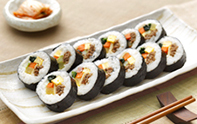
Gimbap
Gimbap is made using rice seasoned with vinegar, sugar and salt. The rice is then placed on a sheet of laver. Strips of eggs, eomuk, carrot, seasoned spinach and pickled radish are then lined up in the middle to be rolled together into a cylinder shape. The roll is then cut into bite-sized pieces. The taste can be quite versatile, depending on the ingredients. Gimbap is a perfect meal option for when you’re on the go!
-
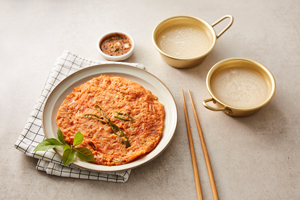
Buchimgae/Jeon
Buchimgae and jeon refer to many pancake-like dishes in Korean cuisine. Meat, seafood, vegetables and eggs are mixed with flour batter and then pan-fried with oil. Each jeon gets its name from the main ingredient used, such as pajeon (green onion pancake), kimchi jeon (kimchi pancake), and bindaetteok (mung bean pancake). The combination of jeon and makgeolli (Korean rice wine) is Koreans’ favorite meal to have on a rainy day.
-
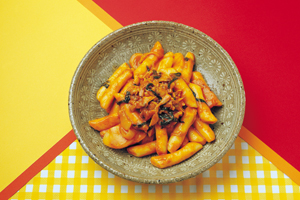
Tteokbokki
Tteokbokki is one of the most common food items sold by street vendors. Cylinder-shaped rice cakes with eomuk and vegetables are cooked in a spicy yet sweet red pepper sauce. Various fusion tteokbokki can also be found, including tteokbokki made using jjajang (black bean sauce) or with garlic toppings.
-
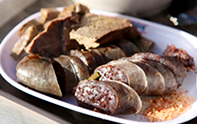
Sundae
Sundae is a traditional sausage made of the lining of pig intestines stuffed with a mixture of bean curd, vegetables and glass noodles. It is usually dipped in seasoned salt and in some regions, it is served with ssamjang, a mixed paste of gochujang and doenjang (fermented soybean paste). Sundae can also be made using squid instead of pig intestines or have glass noodles replaced with glutinous rice.
-
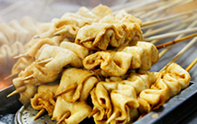
Eomuk
Eomuk’s main ingredient consists of ground fish meat. It is usually skewered and boiled in radish and green onion broth. Eomuk is especially popular as a winter snack.
-
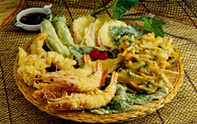
Twigim
Twigim is the general term for deep fried food covered with a batter of flour and eggs. Squid, dumplings, potatoes, shrimp and assorted vegetables are the usual main ingredients. They taste even better dipped in soy sauce or tteokbokki sauce.
-
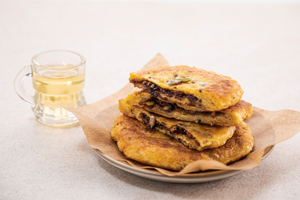
Hotteok
Hotteok are chewy pancakes, usually stuffed with various combinations of sugar and walnuts or pine nuts. A popular street food mostly found in winter, some hotteok are stuffed with vegetables or cheese instead. The dough can come in a unique green color by adding green tea or corn powder..
-

Jwipo/Dried Squid
Jwipo is made of thread-sail filefish that is flattened out and dipped in a sauce then dried. Jwipo and dried squid are usually roasted over a fire before consumption to boost their chewy texture and sweet and savory flavors.
-
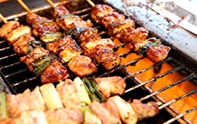
Kkochi
Kkochi refers to cooking skewers of meat. The most common kkochi is dak kkochi, or chicken skewers. Small pieces of chicken and vegetables are skewered, coated in sauce, and then grilled. Sausages, fish cakes and tteokgalbi (grilled short rib patties) are also often skewered, adding fun to choosing your own favorite kkochi.
-
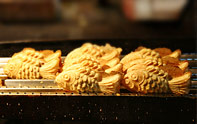
Bungeo ppang/Gukhwa ppang/Gyeran ppang
Bungeo ppang, a favorite winter snack, gets its name from its fish-like shape. This sweet snack is molded in the shape of a carp, called bungeo in Korean. The pancake batter-like shell is filled with red-bean paste, cream or cheese and then baked. Gukhwa ppang is shaped like a flower and is slightly smaller than that of the similar tasting bungeo ppang. Gyeran ppang is also made of a pancake batter-like shell, but is filled with an egg during the cooking process instead of red bean filling.
-
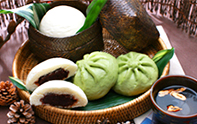
Hoppang
Hoppang is one of the most popular warm snacks in winter. It is a pre-cooked ball of rice flour with various fillings, such as red bean paste, vegetables or pizza ingredients. Hoppang is usually steamed to keep it warm and is sold on the streets and at convenient stores.
This page was last updated on October 7, 2021, and therefore information may differ from what is presented here.
